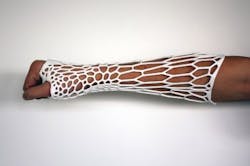3D printed cast created using Microsoft Kinect
A recent graduate of the School of Design at Victoria University of Wellington has developed a 3D printed cast by taking a 3D scan of an injured limb with a hacked Microsoft Kinect.
The cast, called “The Cortex” is a lightweight, washable, and ventilated cast that would replace the older, heavier, and less comfortable casts that are currently used. Jake Evill began the project by researching the structure of a bone he had recently broken in his hand, according to Wired News. He found the trabecular, the tiny honeycomb structure that forms the inner tissue of a bone, to be inspirational and he ended up modeling the Cortex after this pattern, which he says embodies the quality of being strong whilst light just like the bone it is protecting within.
Evill then used a hacked Microsoft Kinect to perform a 3D scan of his injured hand. From there, the image created by the scanner was sent to Shapeways in the Netherlands and printed in 3D in nylon plastic, which will be 3 mm thick and under 500g – a lot smaller than existing plaster casts. In addition, the Cortex allows the skin under the cast area to breathe.
The Cortex printed cast is still very much in the development stage, according to Evill, who says that a more traditional 3D scanner and not a hacked Kinect would probably be beneficial. Evil is currently looking for partners to make the project become a reality.
View the Wired News article.
Also check out:
Tele-rehabilitation booming with Kinect
Kinect-based system optimizes weightlifter's performance
Can Oculus Rift and Kinect revolutionize virtual reality?
Share your vision-related news by contacting James Carroll, Senior Web Editor, Vision Systems Design
To receive news like this in your inbox, click here.
About the Author

James Carroll
Former VSD Editor James Carroll joined the team 2013. Carroll covered machine vision and imaging from numerous angles, including application stories, industry news, market updates, and new products. In addition to writing and editing articles, Carroll managed the Innovators Awards program and webcasts.
